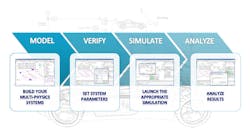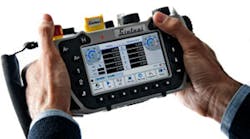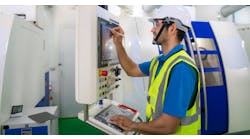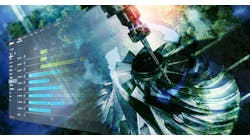LMS issued an updated version of its primary program for mechatronic system simulation, noting it includes new features and improvements that emphasize user efficiency, controls engineering, collaboration and application-oriented solutions. It’s the twelfth revision (Rev12) of LMS Imagine.Lab, and the developer called it “an important step in the usability and user efficiency.”
“Mechatronics” is an interdisciplinary science that coordinates the practical implications of mechanical design, electronics, computer engineering, control technology, and systems engineering. It’s an emerging area of engineering, critical to manufacturers’ production planning but also incorporating details of product design and process logistics, among others. Siemens PLM Software emphasized the importance of mechatronics in manufacturing when it acquired LMS last year for $865 million.
“We are proud at LMS of the work accomplished in the new Rev12 release of Imagine.Lab and the amount of user-valued content it includes,” according to Nicolas Orand, Imagine.Lab solutions directorfor LMS. “The three products of the Imagine.Lab family (AMESim, SysDM, System Synthesis) have all benefited from our increased development efforts toward many new features and constant quality improvements.
“This release is the outcome of the LMS commitment and investment to bringing System Engineering and System Simulation closer for greater industrial products,” he said.
User efficiency is the major emphasis of Rev12, and the new features and other improvements are said to offer help for experts and non-experts working in mechatronic simulation. Among these changes, the new Apps Designer helps design engineers to create “application-specific, pre- and post-processing tools linked to certain models or components.”
Also, improvements to the program’s Supercomponent capabilities include the ability to edit icons, ports and images, and to encrypt Supercomponents to protect intellectual property.
To expand the program’s usefulness for developing and validating process controls, LMS Imagine.Lab Rev12 has a fully integrated, redesigned interface to the Simulink “environment,” a block diagram generator for multidomain simulation and model-based design: thismeans users cancreate and configure the AMESim interface in Simulink without the need for Matlab environment scripts.
Also, an NI VeriStand interface was developed, extending the integration of AMESim into MiL/SiL/HiL processes.
To extend the model-based system engineering capabilities of LMS Imagine.Lab, Rev12 includes an integrated SysDM client for AMESim. With this new feature, AMESim users will benefit from SysDM’s model and data management features through efficient, transparent integration in the day-to-day working environment.
LMS Imagine.Lab Rev12 also brings improvements for System Synthesis, the architecture/configuration management tool, with new capabilities to build system configurations on the basis of tool-neutral system architectures (SysML import.)
Virtual, intelligent design cycle
LMS described its Imagine.Lab product as an “ally” that supports design engineers to manage the growing complexity of mechatronic systems. With validated, application-oriented features, it recommended LMS Imagine.Lab for “virtual, intelligent system design all along the design cycle.”
For example, using Rev12 automotive manufacturers and suppliers will have new abilities to manage routine engineering challenges. Thanks to Apps Designer, new pre- and post-processing tools (Heat Exchangers Calibration, Battery Parameter Identification, Trajectory Generation, Combustion Analysis and Engine Block Parameterization) are provided within AMESim.
Furthermore, Rev12 presents a new “drivability assessment” tool that analyzes the driver perception for each maneuver and returns customizable objective drivability ratings. A new Energy Storage system function, and its associated battery identification tool, allow engineers to model and study the thermal-electric behavior of ultra-capacitors and battery components.
For aeronautics design, LMS Imagine.Lab Rev12 has made significant progress in system design and aircraft integration. The new Aircraft Fuel Systems library introduces a capability to assess the fuel system, but also to cover the whole analysis of thermal integration and inerting/pressurization network.
Also, the new Aircraft Electrics library allows easy, smooth integration of the more electrical aircraft and aids in designing reliable electrical networks.
For mechanical industries, LMS Imagine.Lab Rev12 incorporates new ropes and pulleys components for applications such as cranes and band conveyors. It also proposes a revolutionary approach with the new Adaptive Thermal-Hydraulic solution, making it possible to select the necessary level of assumption for the type of analysis to be performed on fluid systems.
“Rev12 of Imagine.Lab is a step forward in terms of capabilities for system design and system engineering in general. Features such as its flexibility for Thermal-Hydraulic systems and components modeling are very valuable. Its overall capabilities, openness and robustness are key criteria for large deployment and intensive production use of system simulation,” according to Robert Bosch GmbH’s Dr. Lars Reichelt.








